TOKYO — Japanese Prime Minister Shinzo Abe on Friday announced Japan's participation in talks to forge a pan-Pacific free trade deal.
Here are some basic questions and answers on the Trans-Pacific Partnership (TPP).
Q. Where did the TPP come from?
A. Talks started as a smaller trans-pacific strategic partnership involving Brunei, Chile, Singapore and New Zealand, but received a boost when the United States joined in 2008.
U.S. advocates say it could be a building block towards the Free Trade Area of the Asia Pacific (FTAAP), an idea that Washington first raised in 2006.
Q. Who is involved now?
A. Australia, Brunei, Canada, Chile, Malaysia, Mexico, New Zealand, Peru, Singapore, the United States and Vietnam.
Japan will need approval from the other 11 negotiating members before it can formally join the talks, a process that will take at least three months, according to a Japanese foreign ministry official.
China is conspicuously absent. Some analysts suggest the TPP is part of U.S. efforts to contain Beijing, providing an advantageous trading framework for countries who might look to the Chinese market.
Q. How much is it worth?
A. The TPP could develop into the biggest free trade zone in the world, dwarfing the European Union.
The 12 countries have a population of more than 750 million people and combined economic output of $25 trillion, or nearly 40% of the global gross domestic product.
Q. What is up for negotiation?
A. In theory, everything that currently acts as a tariff or a non-tariff barrier to trade in goods and services or in investment.
The accord would also lay down standards for labor, environmental protection, non-discrimination in government procurement and intellectual property rights.
Q. What are sticking points?
A. Japan's participation presents hurdles to a deal that might otherwise be thrashed out relatively simply.
The country's heavily protected farmers are firmly against the plan, fearing the loss of eye-popping tariffs -- rice imports attract a nearly 800% levy -- would expose them to the brisk winds of competition and drive many small-scale operators out of business.
Even though farmers make up a relatively small percentage of voters, Japan's relationship with its countryside and the ideals it represents means there is sympathy for their plight in urban centers.
Japan is also worried that its treasured system of universal public health insurance could be targeted as a non-tariff barrier to American medical services.
The U.S. auto sector, meanwhile, fears unfettered access to its domestic market by Japanese manufacturers will not be matched by the same opportunities for them in Japan.
Q. How might they get round these problems?
A. Outright exemptions are the method of choice for affected industries.
Other options include very long lead-in times for the phasing out of tariffs.
Copyright Agence France-Presse, 2013
About the Author
Agence France-Presse
Copyright Agence France-Presse, 2002-2025. AFP text, photos, graphics and logos shall not be reproduced, published, broadcast, rewritten for broadcast or publication or redistributed directly or indirectly in any medium. AFP shall not be held liable for any delays, inaccuracies, errors or omissions in any AFP content, or for any actions taken in consequence.
